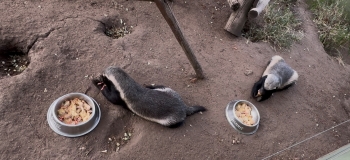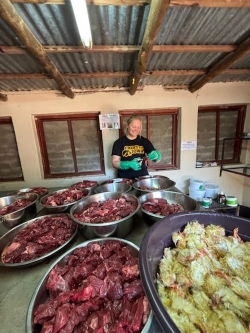Similarly to the previous post, I continued assisting the research team at the Munyawana Conservancy and the Phinda Private Game Reserve in their rhino dehorning efforts aimed at preventing poaching. However, the other volunteers and I had the opportunity to assist with a large-scale relocation and rewilding project for white rhinos. Over 30 years ago, a wealthy man by the name of John Hume initiated a captive breeding program for white rhinos in hopes that the trade of rhino horn would become legal. Eventually, Hume went bankrupt and was no longer able to fund the program, so the rhinos were purchased at auction by African Parks, a non-government organization (NGO), which is similar to non-profit organizations in the United States.
African Parks divided the 2,000 purchased rhinos among several different conservancies and reserves to ensure the vegetation was suitable for the rhinos before translocation. After determining the sufficiency of the food sources, the rhinos are placed into quarantine before being relocated to other areas to ensure the health of both the rhinos and the surrounding animals and vegetation. After the quarantine, at least 50 people from neighboring reserves arrived to assist with the relocation. In an organized fashion, we were divided into different groups, each with a veterinarian on board to ensure the well-being of the animals. A vehicle with a veterinarian on board was also present, equipped with a tranquilizer dart gun that would administer a sedative.
Each rhino was equipped with a microchip, an antibiotic injection, and an identification number was painted on it. They were then loaded into custom-built crates for each rhino’s size. A crane lifted the crates onto a truck, which was then driven to the airport and flown to Rwanda, where they were released. African Parks, CNN Africa, and numerous other news outlets published articles regarding the translocation. The rhinos have since been successfully released into a protected area within Rwanda.
Yellow Team waiting for another rhino to be darted for transport to paint numbers, place microchips, and administer injectable medications
A few days later, I was transported to the Moholoholo Wildlife Rehabilitation Center, near Hoedspruit, South Africa. I was given an extensive tour of the center’s operations, as well as the backstories of the residents. The staff at Moholoholo do incredible work in releasing the animals they can and ensuring they do not become too comfortable with humans. Many of the residents are unable to be released due to physical injury or having been hand-raised by humans. If hand-raised and released, the animals do not know how to be wild and cannot hunt for themselves but will also seek people out and enter houses. I was assigned to Group Four, which is responsible for the care of four honey badgers, the wild dogs, and the white-faced owls. I cleaned and fed the badgers daily for the two weeks I was there.

Each morning at 6:30 a.m. (11:30 p.m. CST), I would begin cleaning the cages of the three white-faced owls and the four badgers: Julius, Rika, Hammie, and Stoffel. Stoffel is the face of the rehabilitation center, so I felt proud to be entrusted with his care. Stoffel is internet famous for escaping his enclosure, outsmarting his caretakers repeatedly. Videos online show Stoffel using tees, stacking rocks, mud, and branches to climb out of the enclosure. At one point, Stoffel escaped and went into the lion cage, where he lost his bottom jaw but managed to kill one of the lions. There is now an electric fence around the enclosure, which keeps him (and me) in. In addition to the honey badgers and owls, I was also responsible for the wild dogs’ water bowl, ensuring it was free of debris and full.
Around 10 am, we would begin what the staff calls “big jobs,” which just take a bit more time and effort to do. Big jobs included measuring and cutting meat for the predators, catching grasshoppers, scrubbing cubicles used by sick vultures, scrubbing feeding cages, etc. In the evenings, we prepare food for our assigned animals, which for the honey badgers and owls consists of day old baby chicks. We have to remove the yolks from the chicks every other day as too much fat causes gastrointestinal upset. We wait for the daily tours to conclude, and the honey badgers are waiting eagerly for their dinner. We keep track of the eating habits by tracking how many chicks were offered and how many were eaten each day.
 Measuring and cutting of meat for the predators (Cheetahs, Wild dogs, Leopards, Hyenas). Also pictured are the chicks fed to the remaining animals such as the badgers, owls, and vultures.
Measuring and cutting of meat for the predators (Cheetahs, Wild dogs, Leopards, Hyenas). Also pictured are the chicks fed to the remaining animals such as the badgers, owls, and vultures. Overall, I am incredibly impressed by the Moholoholo Wildlife Rehab Center staff and their methods of ethically raising orphaned animals and caring for ill and injured ones. The ultimate goal is to release any animals they can and to keep them wild by ensuring they do not form an attachment with humans. I have another week here, but this is definitely an amazing experience I would love the opportunity to do again.